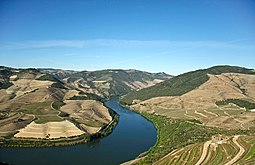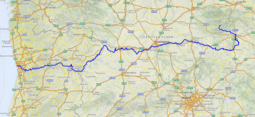| Douro | |
|---|---|
 The river flowing through the Portuguese wine region, designated as a World Heritage Site. | |
 | |
| Location | |
| Country | Spain, Portugal |
| Physical characteristics | |
| Source | Picos de Urbión |
| • location | Sistema Ibérico, Duruelo de la Sierra, Soria, Castile and León, Spain |
| • coordinates | 42°0′38″N 2°52′49″W / 42.01056°N 2.88028°W |
| • elevation | 2,157 m (7,077 ft) |
| Mouth | Foz do Douro |
• location | Atlantic Ocean, Porto, Greater Porto, Norte, Portugal |
• coordinates | 41°8′36″N 8°40′10″W / 41.14333°N 8.66944°W |
• elevation | 0 m (0 ft) |
| Length | 897 km (557 mi) |
| Basin size | 98,400 km2 (38,000 sq mi) |
| Discharge | |
| • location | Porto |
| • average | 700 m3/s (25,000 cu ft/s) |
| • maximum | 17,000 m3/s (600,000 cu ft/s) |
| Discharge | |
| • location | Pocinho |
| • average | 442 m3/s (15,600 cu ft/s) |
| Basin features | |
| Tributaries | |
| • left | Tera, Rituerto, Riaza, Duratón, Cega, Adaja, Tormes, Huebra, Águeda, Côa, Torto, Távora, Varosa, Bestança, Paiva, Arda, Inha |
| • right | Pisuerga, Valderaduey, Esla, Sabor, Tua, Corgo, Tâmega, Sousa |
 | |
The Douro (UK: /ˈdʊəroʊ, ˈdʊəruː/, US: /ˈdɔːruː, ˈdɔːroʊ/,[1][2][3][4] Portuguese: [ˈdo(w)ɾu], Mirandese: [ˈdowɾʊ]; Spanish: Duero [ˈdweɾo]; Latin: Durius) is the largest river of the Iberian Peninsula by discharge. It rises near Duruelo de la Sierra in the Spanish province of Soria, meanders briefly south, then flows generally west through the northern part of the Meseta Central in Castile and León into northern Portugal. Its largest tributary (carrying more water than the Douro at their confluence) is the right-bank Esla.[5] The Douro flows into the Atlantic Ocean at Porto, the second largest city of Portugal.
The scenic Douro railway line runs close to the river. Adjacent areas produce port (a mildly fortified wine) and other agricultural produce. A small tributary of the river has the Côa Valley Paleolithic Art site which is considered important to the archaeological pre-historic patrimony, designated a UNESCO World Heritage Site. Within Spain, it flows through the middle of the autonomous community of Castile and León, with the basin spanning through the northern half of the Meseta Central. The latter includes wine producing areas such as the Ribera del Duero DOP.
- ^ "Douro". The American Heritage Dictionary of the English Language (5th ed.). HarperCollins. Retrieved March 31, 2019.
- ^ "Douro". Collins English Dictionary. HarperCollins. Retrieved March 31, 2019.
- ^ "Douro" (US) and "Douro". Lexico UK English Dictionary. Oxford University Press. Archived from the original on 2020-07-30.
- ^ "Douro". Merriam-Webster.com Dictionary. Merriam-Webster. Retrieved March 31, 2019.
- ^ Fernández-Aláez, M.; Fernández-Aláez, C.; Luis Calabuig, E. de (1992). "The Esla River Basin: From the Cantabrian Mountain to the Duero" (PDF). Limnetica. 8 (1): 131. doi:10.23818/limn.08.12. S2CID 245777871.